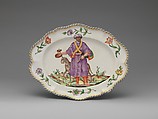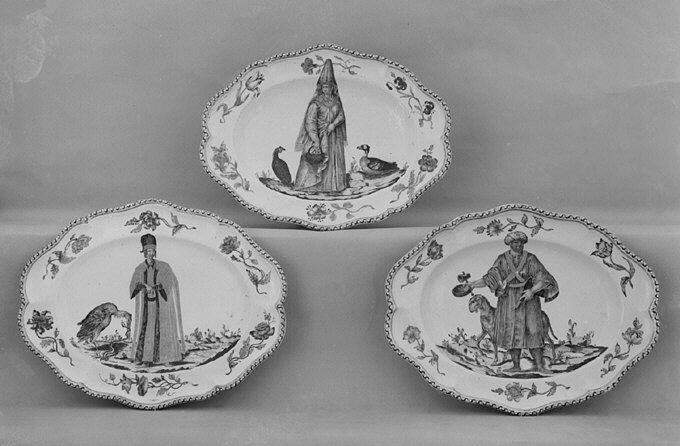Platter (one of a set)
Manufactory Doccia Porcelain Manufactory Italian
Factory director Marchese Carlo Ginori
Not on view
The first factory in Italy to produce hard-paste porcelain was founded in Venice in 1720 by Francesco Vezzi (Italian, 1651–1740), but this enterprise was short-lived and closed in 1727. A far more ambitious and successful hard-paste porcelain factory was established ten years later outside of Florence at Doccia by Carlo Ginori (Italian, 1702– 1757), and it became one of the most significant European factories during the eighteenth century. The Doccia factory, as it is commonly known, continued after Ginori’s death and remained under family control until merging with a Milanese firm at the end of the nineteenth century, but Doccia’s period of greatest artistic innovation took place under Carlo Ginori’s directorship from 1737 to 1757.[1]
Considerable recent scholarship on the Ginori factory has underscored both the political circumstances in Florence at the time the factory was established and the importance of Ginori’s role in the factory’s founding and early growth.[2] The death in 1737 of the last Medici to rule Florence, Grand Duke Gian Gastone (1671–1737), shifted control of the region to the House of Habsburg-Lorraine in Vienna. With the transference of governance, court patronage within Florence ceased, causing a subsequent decline in artistic activity.[3] Within this changing environment, Ginori was successful in establishing a porcelain factory lacking the active support of a local court or ruler, which is in contrast to the majority of porcelain enterprises founded during the eighteenth century in Europe.
Ginori’s keen interest and active involvement in the factory’s production are well documented. Trained as a chemist, he provided the technological expertise in the area of pastes, glazes, and enamels. It appears that Ginori began experimenting with ceramics as early as 1734,[4] but it was during a trip to Vienna to acknowledge the new rulers of Florence in 1737 that he met two workers at the Claudius Innocentius Du Paquier factory, who would become instrumental to the new factory’s success. Ginori was able to entice the painter Carl Wendelin Anreiter von Ziernfeld (Slovakian, 1702–1747) and kiln master Giorgio delle Torri (culture unknown, active at Doccia 1737–43) [5] to Florence to assist with Ginori’s experiments. In addition, he hired sculptor Gaspero Bruschi (Italian, 1710–1780) and chemist Jacopo Fanciullacci (Italian, 1705–1793), and soon the Ginori factory was in a position to secure patents in 1741,[6] by which time its first porcelains were in production.
This tray dates from 1745 to 1747, the years in which the factory began producing on a commercial scale. An inventory taken after the death of Ginori in 1757 indicates that it was one of twenty oval trays that, along with two round plates, were decorated with “Turkish figures.”[7] In addition, the inventory notes that these figures derived from a painted manuscript housed in the Gaddi library, a scholarly library in Florence founded in the sixteenth century. The figures in the manuscript were painted by Jacopo Ligozzi (Italian, 1547–1627), a prolific artist who became a court painter to the Medicis. The majority of Ligozzi’s figures depict men and women from the Ottoman Empire, and their costumes and hats are as much his focus as are their facial features. Ligozzi appears to have based many of his depictions on those found in Nicolas de Nicolay’s (French, 1517–1583) Les navigations, peregrenations et voyages, faicts en la Turquie (1576), although Ligozzi has added animals that figure prominently in each of his compositions. Both the manuscript with Ligozzi’s figures and the book by de Nicolay reflect the deep interest in publications that recorded figures and customs from foreign lands, especially those deemed to be “exotic” by western Europeans in the late sixteenth and seventeenth centuries.
Three of the eleven surviving trays and plates are now in the Museum (06.372a–c).[8] One tray depicts a woman from Caramania (referring to a part of Asia Minor) as identified in Ligozzi’s painting (Galleria degli Uffizi (Polo Museale Fiorentino), Florence (inv. no. 2950 F; cat.fig. 20); a second illustrates a man whose origin is not cited by Ligozzi but identified in Les navigations as “Sacquaz from a Moorish country, a porter of water and pilgrim of Mecca”;[9] and the third portrays a Turkish youth whom Ligozzi titles “a page of the grand Turk.”[10] The figures on the Museum’s trays and the animals that accompany them closely copy those painted by Ligozzi, and even the palette used by the Doccia painter reflects the same employed by Ligozzi, suggesting that the manuscript was made available to the factory for copying. The quality of the decoration on the porcelain is extremely high, and it has been traditionally attributed to Anreiter, the painter from Vienna cited above, who may have been aided by his son Anton Anreiter van Zirnfeld (1727–1801).[11] The borders of the New York trays and other surviving examples are decorated with large-scale sprays of naturalistic flowers that are similar stylistically to those frequently found on Du Paquier porcelain,[12] reflecting both Anreiter’s prior employment by the Viennese factory and the role that factory played in the formation of Ginori’s enterprise. In contrast to Du Paquier porcelain, however, the hard-paste body made by Doccia was noticeably gray in tone. While the pastes employed by the factory varied considerably over a period of several decades,[13] the development of a porcelain paste deemed to be sufficiently white remained a technical challenge through the end of the eighteenth century. The gray bodies of the Museum’s trays in addition to a certain coarseness to the paste points to a relatively early date of manufacture, and this supposition is reinforced by the incised numbers or letters on the back of one of the trays.[14]
Footnotes
1 For a history of the factory, see Agliano 2005a; Biancalana 2005; Biancalana 2009; Agliano 2010; Biancalana 2011; Agliano 2013; Agliano 2014, pp. 272–74.
2 Agliano 2010.
3 Ibid., p. 79.
4 Biancalana 2009, p. 16.
5 There are variants to the way delle Torri’s name is spelled, including Georg Deledori and Giorgio Delle Dori.
6 Biancalana 2005, p. 73.
7 Agliano 2010, p. 80.
8 Andreina d’Agliano in Kraftner 2005, pp. 380–81, no. 239. When known, the locations of the other eight are cited.
9 See Kraftner 2005, p. 384.
10 The inscription on the tempera reads adicci oglani/sono gli paggi del grá turcho; see Forlani 1982, p. 95.
11 Agliano 2010, p. 80.
12 See, for example, Zelleke 2009a, p. 400, fig. 4:129.
13 Agliano 2010, p. 79.
14 Agliano 2005a; Biancalana 2005.
Due to rights restrictions, this image cannot be enlarged, viewed at full screen, or downloaded.
This artwork is meant to be viewed from right to left. Scroll left to view more.



